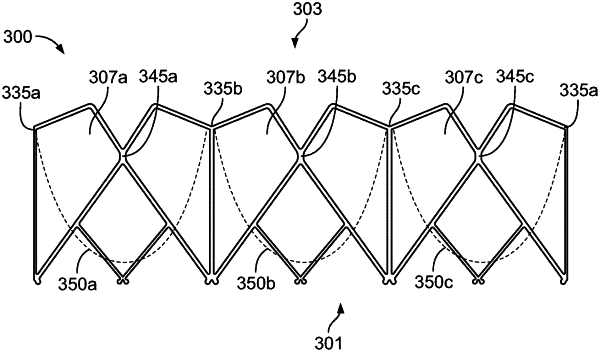| CPC A61F 2/2418 (2013.01) [A61F 2/2433 (2013.01); A61F 2220/0075 (2013.01); A61F 2230/0017 (2013.01); A61F 2230/0054 (2013.01)] | 12 Claims |

|
1. A prosthetic heart valve, comprising:
a collapsible and expandable stent extending in an axial direction from a first inflow end to a second outflow end, the collapsible and expandable stent having a plurality of vertical struts that are parallel to the axial direction in an expanded condition of the stent, and a plurality of oblique struts that are oblique to the axial direction in the expanded condition of the stent;
a cuff coupled to the stent; and
a plurality of prosthetic leaflets disposed within the stent, the plurality of prosthetic leaflets configured to allow blood to flow in an antegrade direction from the first inflow end toward the second outflow end of the stent, and to substantially block blood from flowing in a retrograde direction from the second outflow end of the stent toward the first inflow end of the stent,
wherein the plurality of oblique struts are coupled to the plurality of vertical struts so that, upon transitioning from the collapsed condition to the expanded condition, the first inflow end of the stent remains substantially static relative to the axial direction while the second outflow end of the stent moves in the axial direction toward the first inflow end; wherein each section of the plurality of oblique struts includes a first pair of oblique struts forming a first half-diamond shaped cell at the first inflow end of the stent, and a second pair of oblique struts forming a second half-diamond shaped cell at the first inflow end of the stent; the first pair of oblique struts includes a first oblique strut coupled to the first end of a first one of the vertical struts, and a second oblique strut, and the second pair of oblique struts includes a third oblique strut coupled to the second oblique strut at the first inflow end of the stent, and a fourth oblique strut coupled to a first end of a second one of the vertical struts; and wherein each section of the plurality of oblique struts includes fifth and sixth oblique struts coupled to each other, the fifth oblique strut coupled to the second oblique strut, and the sixth oblique strut coupled to the third oblique strut, so that together the second, third, fifth, and sixth oblique struts form a diamond-shaped cell, the diamond-shaped cell being positioned substantially midway between first and second ones of the vertical struts.
|